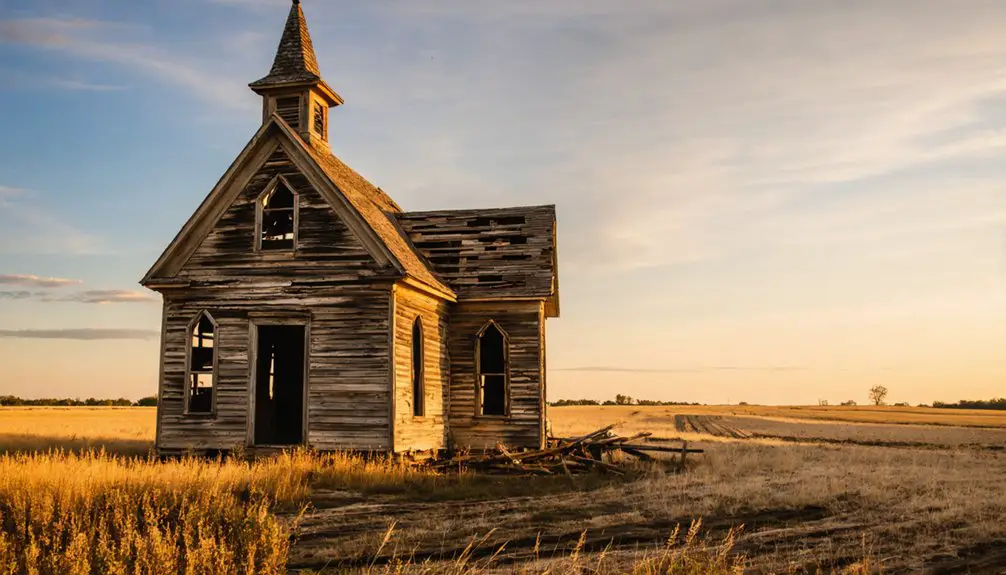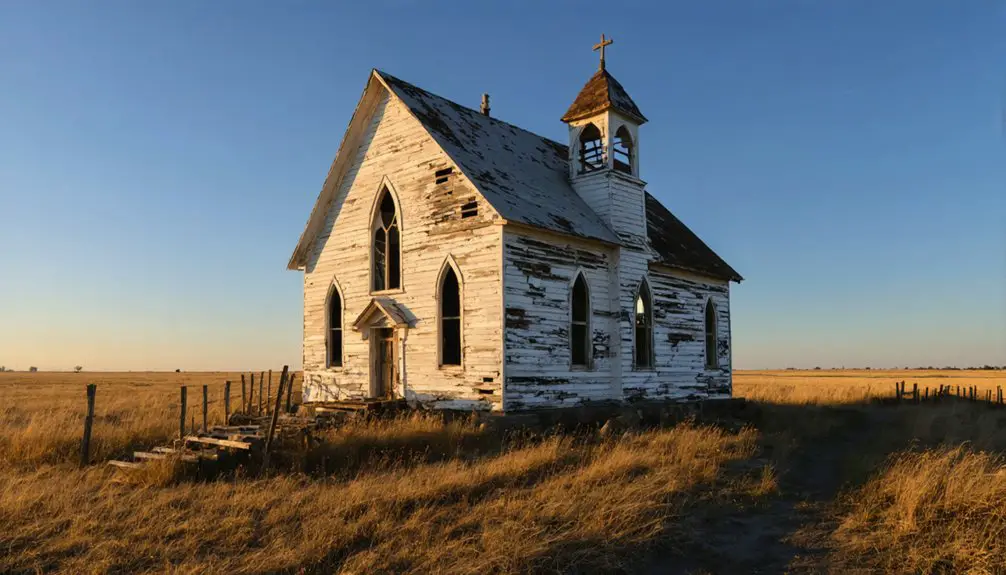You’ll find Harlan, Kansas transformed from a thriving 1870s agricultural settlement into one of the state’s haunting ghost towns. Originally named Thompson, this Smith County community emerged around Gould College in 1881, featuring a lively racetrack and seasonal harvest festivals. After World War II, the town gradually declined until its post office closed in 1995. Today, you can explore the remaining high school gymnasium and Main Street buildings, where echoes of frontier life still linger.
Key Takeaways
- Harlan transformed from a thriving 1873 agricultural settlement into a ghost town, marked by its post office closure in 1995.
- The town’s remains include a historic high school gymnasium, Main Street buildings, and grain elevators symbolizing its agricultural past.
- Gould College, established in 1881, served as the town’s cultural cornerstone before Harlan’s post-WWII economic decline.
- Originally named Thompson in 1873, the town was renamed Harlan in 1877 and developed around farming and livestock.
- Preservation efforts document Harlan’s history through photographs, maps, oral histories, and digital archives to maintain its legacy.
The Rise and Fall of a Kansas Settlement
As settlers pushed westward across Kansas in the late 19th century, a small community called Thompson emerged in Smith County in 1873.
You’ll find that this settlement evolution took a significant turn when the town changed its name to Harlan in 1877, establishing itself as one of many hopeful agricultural communities dotting the prairie landscape.
The town’s early promise was marked by the establishment of Gould College in 1881, which operated for a decade and signaled the community’s commitment to education. Like Clonmel’s agricultural activities, farming remained the backbone of the local economy.
Agricultural practices dominated Harlan’s economy, with local farmers and merchants building a modest but stable community through the early 20th century. Similar to Minersville’s dependence on lignite coal mining, different economic activities shaped the destinies of Kansas towns.
However, like many rural Kansas towns, Harlan’s liveliness gradually diminished after World War II, ultimately leading to the closure of its post office in 1995.
Life in Early Harlan
If you’d settled in early Harlan, you would’ve found your days filled with the demanding routines of farm life, hauling lumber for construction, and tending to livestock along the water sources.
Early settlers endured the severe 1878 drought that devastated local agriculture and required aid from Eastern Kansas.
You might’ve joined your neighbors at the local racetrack or picnic grove, where the ranching community gathered for much-needed social interaction and respite from daily labors.
Your social calendar would’ve included events at Gould College, the United Brethren Church institution that served as a cultural cornerstone for the developing settlement.
Settlers faced tremendous challenges during winter months when deep snow and cold made accessing basic provisions nearly impossible.
Daily Farm Life
Life on a Harlan farm demanded relentless physical labor from sunrise to sunset, with each season bringing its own set of challenges and tasks. You’d start your day drawing water from the well and tending to livestock before heading to the fields.
Farm chores followed strict seasonal rhythms – spring planting, summer cultivation, and fall harvest. Like the non-religious Quakers who first settled here, farmers maintained a simple but industrious lifestyle. The valley’s rich farmlands attracted many settlers despite warnings about flooding risks.
Your modest wooden farmhouse served as the center of operations, with nearby outbuildings housing essential tools and animals. You’d work the soil using horse-drawn plows, rotating crops to maintain fertility.
While men handled the heavy fieldwork, women managed the kitchen garden, preserved food in root cellars, and cared for poultry. Children pitched in too, helping with everything from milking cows to gathering eggs.
Despite the isolation and technological limitations, you’d find ways to remain self-sufficient through all weather conditions.
Community Gatherings and Events
Though Harlan was a small farming community, its residents found countless opportunities to gather and celebrate throughout the year.
You’d likely have attended seasonal harvest festivals where local farmers showcased their crops and livestock, while community celebrations centered around Gould College brought together students and townspeople alike.
These social gatherings often took place in the town’s public buildings or local churches, where you’d join your neighbors for potluck suppers, dances, and community meetings.
Women played pivotal roles in organizing these events, from church socials to agricultural fairs.
Like many towns in the region such as Bell Plane, Harlan’s economy depended heavily on agriculture and apple orchards.
As a tight-knit rural community, you’d have experienced the strong bonds formed through mutual support at these gatherings, which helped sustain Harlan’s vibrant social life throughout its heyday.
Like the early settlers of Columbia who established a log store and blacksmith to serve their community, Harlan’s gathering places became essential hubs of both commerce and socializing.
What Remains Today
While Harlan’s bustling days have faded into history, several structures still stand as silent witnesses to the town’s past.
You’ll find the high school gymnasium serving as a prominent landmark, surrounded by the weathered remains of Main Street’s commercial buildings. For urban exploration enthusiasts, the town offers glimpses of architectural remnants like old fireplaces and concrete bathtubs within deteriorating homes. Much like the town of Bodie, California, Harlan fell victim to dwindling resources and eventual abandonment. Similar to Alexander’s former school building from 1916, many historic structures remain empty as testament to busier times.
Though Harlan hasn’t completely surrendered to ghost town tourism, you’ll encounter a handful of occupied homes where resilient residents maintain their properties.
The closed post office, which operated until 1995, stands as a reminder of the town’s decline. Scattered throughout the landscape, you’ll spot grain elevators and silos – enduring symbols of Harlan’s agricultural heritage, now largely silent in the Kansas wind.
Tales From Local Residents
Beyond the weathered buildings and silent grain elevators, the richest remnants of Harlan’s history live on through its storytellers.
Through interviews and informal gatherings, former residents share tales of both everyday life and ghostly encounters that shaped their experiences in this Kansas community.
Local voices weave together memories of daily routines and supernatural mysteries, keeping Harlan’s spirit alive through their shared stories.
- You’ll hear accounts of unexplained shadows and eerie noises near abandoned structures, particularly after sunset.
- You’ll discover stories of vibrant social gatherings, from lively baseball games to community dances that once filled the town with energy.
- You’ll learn about the challenging shift from a thriving agricultural hub to a ghost town, as told by those who witnessed the gradual exodus.
These resident experiences paint a complex portrait of Harlan’s transformation, preserving memories of both its spirited past and its haunting present.
Historical Landmarks and Architecture

Three notable landmarks stand as silent witnesses to Harlan’s architectural heritage: the weathered ruins of Main Street’s commercial district, the skeletal remains of the high school gymnasium, and the historic Gould College building constructed between 1881 and 1891.
These structures showcase the architectural influences of late 19th-century Kansas, when the town was known as Thompson before its 1877 name change. You’ll find the buildings were constructed with practical materials readily available on the plains – wood, stone, and brick – reflecting both economic necessity and cultural values of the era.
The historical significance of these remaining structures, particularly the educational buildings, points to a community that valued learning while adapting to life on the frontier.
Preserving Harlan’s Legacy
You’ll find that Harlan’s preservation efforts rely heavily on meticulous documentation through photographs, maps, and land records housed in local historical societies.
The collection of oral histories from former residents and their descendants provides invaluable firsthand accounts of life in this Kansas ghost town.
Digital archives now safeguard these community memories, while social media platforms help share Harlan’s story with wider audiences interested in rural Kansas history.
Historical Documentation Methods
Preserving Harlan’s legacy requires a thorough approach to historical documentation that aligns with established preservation standards.
You’ll find that maintaining historical accuracy while documenting this Kansas ghost town presents unique documentation challenges, especially when capturing the town’s decline from its peak population through its abandonment.
- Document physical remains through standardized inventory forms, including building foundations, cemetery plots, and any surviving structures over 50 years old.
- Collect extensive data through field research, archaeological surveys, and ethnographic studies specific to Harlan’s geographical boundaries.
- Partner with local historical societies, tribal representatives, and cultural institutions to gather firsthand accounts and traditional knowledge about Harlan’s past.
You’re contributing to a crucial historical record when you follow these established documentation methods, ensuring Harlan’s story endures for future generations.
Community Memory Collection
Building on established documentation methods, the collection of community memories forms the heart of Harlan’s historical preservation efforts.
You’ll find local residents and former inhabitants gathering at churches, schools, and community centers to share their personal stories through oral history interviews. These firsthand accounts capture the essence of daily life in Harlan, from its bustling peak to its shift toward ghost town status.
Memory preservation extends beyond spoken words. Local families contribute photographs, letters, diaries, and artifacts that tell Harlan’s story.
Through partnerships with regional historical societies, these precious items find proper care and documentation. Digital platforms now make these collected memories accessible to researchers, descendants, and history enthusiasts, ensuring that Harlan’s legacy lives on despite its dwindling population.
Frequently Asked Questions
Are There Any Paranormal or Supernatural Stories Associated With Harlan?
You’ll find ghost sightings at the haunted courthouse, where Manzo Shepherd’s spirit lingers after his violent death. You can explore these paranormal hotspots through Bloody Harlan Tours year-round.
What Is the Best Time of Year to Visit Harlan?
You’ll find the best seasons to visit are spring and fall, when weather conditions are mild and comfortable. You can explore freely without summer’s intense heat or winter’s harsh conditions.
Can Visitors Legally Explore Abandoned Buildings in Harlan?
While you might dream of abandoned exploration, you can’t legally enter buildings without explicit owner permission. Trespassing laws and safety concerns make unauthorized entry a risky legal violation you’ll want to avoid.
How Far Is Harlan From the Nearest Major City?
You’ll find Wichita, the nearest major city, about 60 miles east-southeast of Harlan’s haunting remains – roughly a 70-minute drive through Kansas plains where early settlers once traveled.
Are There Any Annual Events or Gatherings Still Held in Harlan?
You won’t find any active annual events or community gatherings in Harlan today. As a ghost town, its history of local gatherings has faded, with no documented traditions continuing into modern times.
References
- http://kansasghosttowns.blogspot.com/2016/03/nonchalanta-dead-town-in-ness-county.html
- https://www.youtube.com/watch?v=kXDeasPSwhE
- https://legendsofkansas.com/kansas-ghost-town-list/
- https://legendsofkansas.com/grant-county-kansas-extinct-towns/
- https://www.humanitieskansas.org/get-involved/kansas-stories/places/mining-for-stories-in-a-kansas-ghost-town
- https://www.youtube.com/watch?v=VPZtNoncnig
- https://www.familysearch.org/en/wiki/Phillips_County
- http://www.kancoll.org/books/andreas_ne/harlan/harlan-p1.html
- https://legendsofkansas.com/hodgeman-county-kansas/
- https://fhsuguides.fhsu.edu/kansasheritage/smithcounty



